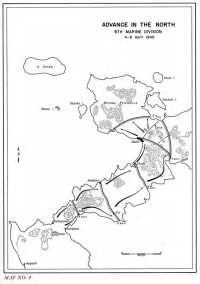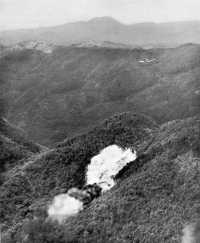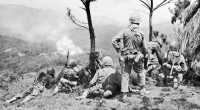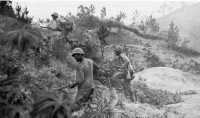Chapter 6: The Conquest of North Okinawa
“All restrictions removed on your advance northward.”1 This message from General Buckner reached General Geiger, commander of III Amphibious Corps, on 3 April as the 6th Marine Division was approaching the Nakadomari–Ishikawa line. The message marked an important change in the Okinawa plan. Originally, as part of Phase II, the capture of Motobu Peninsula and the neutralization of northern Okinawa were to come after the seizure of southern Okinawa. General Buckner’s order placed the northern operations in the first phase and permitted the III Amphibious Corps to attack the enemy in the north while the XXIV Corps was closing with the Shuri defenders in the south.
There were good reasons for attacking northward without delay. The sooner this was done the less chance the enemy would have to organize his forces and fortify his positions. Colonel Udo, commander of the Japanese forces in the north, was known to be organizing the Okinawans for guerilla warfare. There was also the threat of counter-landings in the small ports of northern Okinawa by Japanese moving in from other Ryukyu islands or from Japan itself; by securing the ports this threat could be removed2
Drive up the Ishikawa Isthmus, 4-7 April
By early afternoon of 4 April columns of the 6th Marine Division were moving down off the high coral cliffs that overlook Ishikawa Isthmus, the narrow waist of the island leading off to the north, and were advancing to the long beach that faces the sea at the town of Ishikawa on the east coast. Here the forces of the division gathered. The marines were footsore and weary, but their spirits
were high. North of the Nakadomari–Ishikawa line scattered groups of Japanese were straggling toward Motobu Peninsula; south of it American tanks were moving up to assembly areas while engineers were organizing dumps and bulldozing wide roads toward the isthmus. (See Map 17.)
This “rear area” work by the engineers was vital, for the advance up the isthmus was to be primarily a logistical effort. From the Nakadomari–Ishikawa line to the base of Motobu Peninsula there were two narrow roads, one along each coast, which were difficult to widen because they frequently ran along sea walls or wound around steep hills. Aerial reconnaissance had indicated that many bridges were out. Between the coastal roads was a rugged mountain range, covered with brush and grass. At long intervals roads and trails crossed the isthmus. The 6th Marine Division’s hardest task was to move troops, vehicles, supplies, tanks, and guns over these one-way roads without losing the momentum that had been moving the division ahead at the rate of 7,000 yards a day.
The advance up the isthmus was spearheaded by the 22nd Marines. Its tank-infantry teams moved along the coasts, making short patrols inland. Along the high ground in the center its 1st Battalion proceeded more slowly, patrolling trails and intercepting enemy stragglers. When the 22nd reached the AtsutabaruKin line, the regiment paused while the 4th Marines passed through on the east and the 29th on the west. The marines encountered only stragglers except during the night of 5-6 April, when from thirty to forty Japanese blundered into their lines and were killed or driven off.
Both regiments continued to advance with great rapidity. The division prescribed a method of leapfrogging that at the same time freed the roads and provided security. As the battalions pressed ahead, platoons peeled off to patrol in advance or on the flanks. Their mission completed, they returned to the rear of the column. Trucks and supplies followed swiftly as engineers cleared roads and repaired bridges. LVTs and LSTs waited for the troops to secure likely inlets or bays where they could unload.
The 29th Marines reached Chuda on 6 April and threw a line across the isthmus on the road there. In its sector the enemy’s destruction of bridges had been inept; frequently only a span of the bridge had been dropped or cracked. The engineers cut hasty bypasses for the vehicles, repairing the broken spans later. The 4th Marines, however, was delayed by blown bridges, since destruction had been more effective in its sector on the east coast; at one point engineers had to set in a 120-foot bridge.
Map 4: Advance in the North, 6th Marine Division
Behind reconnaissance units and tanks the 29th Marines advanced on 7 April into Nago, a medium-sized town nestling in the deep bend where Motobu juts out westward from the island. A spearhead drove north to Taira, cutting Motobu off from the rest of Okinawa; other troops started west from Nago along the coast road to Awa. Here for the first time there was evidence that he troops were meeting not stragglers but outposts of an organized defense, for the marines became involved in a few small fire fights and met some organized rifle fire. They had reached Motobu Peninsula, which for some time was to be the focus of the III Amphibious Corps’ effort.
Probing the Motobu Defenses, 7-13 April
Motobu Peninsula was largely unknown territory to the Americans. Much of the interior was cloud-covered when the first photographs were taken; later photographs failed to disclose important trails hidden under the trees; it was only after a Japanese map had been captured that the complete road network was made clear. To gain a better idea of the terrain of Motobu and the nature of the enemy positions, the 6th Marine Division conducted an intensive reconnaissance of the peninsula.
The Reconnaissance Company on 7 April followed the road around the southern and western coasts of Motobu. Broken bridges forced the troops to leave the tanks behind and to proceed on foot. Just offshore five LCIs moved slowly along, firing into the hills and cliffs ahead of the troops. The company rounded the southwestern corner of Motobu and drew up abreast of the silent island of Sesoko. After exploring the deserted town of Suga the troops marched back. Not a shot had been fired at them. A prisoner of war said later that the Americans had been under constant observation but that the Japanese had let them pass, waiting for bigger game.
The marines found the peninsula to be virtually a country in itself, inhabited by mountain farmers who dug out their plots on steep slopes. As Motobu broadened out, the area inland rose in a series of slopes topped by a sprawling, twisted mass of rocky ridges and ravines called Yae-Take, the highest points of which were close to 1,500 feet. This mass was to prove the critical terrain feature of the peninsula. The lower ridges were heavily wooded; the upper areas were covered with grass and a few stunted trees. Hills bordered Motobu Peninsula on its western end, broken only where the Manna River ran through to the inlet on which Toguchi was located. On the northern side a small group
Fire-bombing aided the advance in northern Okinawa. A Marine fighter plane (F4U) has flown low and dropped its fire bomb on an enemy-held slope in the rugged north
of islands formed a protecting harbor; here the Japanese had established a midget submarine base, a torpedo station, and an operating point for suicide boats. The more important towns lay on the flatlands along the coast. Two towns in the interior were to prove tactically important: Manna, one and a half miles east of Toguchi, and Itomi, two miles northeast of Yae-Take. (See Map XIV.)
From 8 to 11 April the 29th Marines made efforts to fix the position of the enemy on Motobu. The 2nd Battalion struck out to the north coast of the peninsula but encountered only occasional Japanese soldiers. The other battalions of the 29th found a different situation in the area around Yae-Take. The 3rd Battalion reached Toguchi on 10 April, despite a brief shelling en route by two enemy artillery pieces and heavy mortars which caused sixteen casualties. From Nago the 1st Battalion drove inland in a northwesterly direction to Itomi, overcoming a small ambush at the approaches to the town. The 1st and 3rd Battalions, 29th Marines, were now separated from each other only by the 3-mile trail between Itomi and the Toguchi area; they had almost surrounded Yae-Take.
Closing the ring around Yae-Take proved to be difficult. When the 3rd Battalion of the 29th tried to push inland east from Toguchi, the marines were stopped in the narrow defiles in the Manna area by mortar and machine-gun fire. The 1st Battalion of the 29th picked its way from Itomi along a winding trail bordered by steep slopes. When the men were close to Manna and could see the ocean, Japanese mortars and machine guns opened up from the heights. The enemy fire split up the column, and the marines withdrew to Itomi, forcing their way past another ambush on the way back.
By 11 April the intelligence officer of the 6th Marine Division could draw a great red oval on his map of Motobu and set up fairly accurately the outermost limits of enemy resistance. After further intense patrolling around Yae-Take on 12 and 13 April, during which the marines had frequent brushes with enemy groups, more information came in on the enemy’s defenses and probable plan. Colonel Udo, apparently adopting a passive defense, was not sending his men out of the Yae-Take area; moreover, he was cautiously husbanding his troops and ammunition by not engaging the American forces until late in the afternoon, when it was too late for them to send an expedition into the hills. It was already apparent that he hoped to keep alive a center of guerilla resistance and to delay the Americans rather than destroy them.
Colonel Udo’s command post in a ravine on Yae-Take had excellent radio and telephone communications with strategically located outposts. The Japanese were well prepared for mountain warfare; they knew the trails and had horses,
the best means of transportation over this terrain. The enemy was especially strong in automatic weapons, among them 25-mm. naval guns set in emplacements in the hill masses. Though the forces in the north were generally weak in equipment and supplies, the best of what was available had been concentrated in Motobu. With mortars and machine guns that were easily carried, with fixed 25-mm. guns, and with at least a battery of field artillery, Colonel Udo might well have hoped to maintain for a considerable time his control of this mountain stronghold.
Closing In on Yae-Take, 14-15 April
Under orders to “destroy remaining enemy forces on Motobu,” the 6th Marine Division on 13 April laid plans for the assault on the Yae-Take positions. The plan was for the 1st and 2nd Battalions, 4th Marines, and the 3rd Battalion, 29th, all under the command of Col. Alan Shapley, to attack Yae-Take from the west. From the east the 1st and 2nd Battalions of the 29th were to march from Itomi and occupy the high hills north of the Itomi–Manna road. A battle of maneuver and of opportunity was in prospect since units could not maintain contact. Company and battalion leaders would have to decide methods of approach up the ridges and narrow valleys, and to change those methods on their own initiative when necessary. The infantry would have to depend on its organic weapons; artillery and air strikes would prove more effective when the heights were taken, but tanks were out of the question.
The 6th Marine Division could now focus its effort on the Yae-Take defenses without fear of major diversion to its rear on northern Okinawa. On 13 April, after a fast trip along the west coast by foot, LVT, and truck, the 2nd Battalion, 22nd Marines, reached Hedo Point at the north tip of Okinawa. On the way the marines had met virtually no opposition. Other elements of the 22nd worked along the east coast of northern Okinawa. From bivouac areas on the coast, company patrols penetrated deep into the mountainous interior of the island. The patrols reconnoitered the interior on trips lasting several days; they then returned to the coast, where they were picked up by LVTs.
Nago, the site of the division command post, was now a nerve center; supplies for the operations were being brought to its harbor by LSTs as the long road haul over the isthmus had been largely abandoned. Control of roads south of Nago had been transferred to Corps; division engineers were now assembling bridging material for use on Motobu. The rapid advance strained every resource of the shore parties, who had based their plans on the expectation that the division
Pushing to Yae-Take, infantrymen of the 6th Marine Division pause on a mountain top while artillery shells a Japanese position. Meanwhile another group of marines (below) makes its way up a hillside, probing cave openings and watching for Japanese to show themselves
would be near the Hagushi beaches for the first fifteen days; supplies and gear, however, rolled ahead with the troops.
On 14 April Colonel Shapley’s three battalions attacked east toward YaeTake, and by evening they had a firm hold on the first ridges. The marines met running opposition from small groups of machine gunners and riflemen. The enemy had good observation of the marines’ movements; his machine guns and mortars covered the approach routes; and he followed his custom of allowing a few troops to pass across an open saddle and then firing on the group from behind. American officers were his favorite target. It was dangerous to hold a map, to wave a directing arm, or even to show a pistol rather than a carbine or rifle. Under the circumstances the companies deployed rapidly, and on many occasions the approach march became a series of assaults as fire teams engaged with enemy outposts. The marines, accustomed to grappling with solid defense lines on small islands, now had to use tactics of maneuver “right out of the book.”
More maneuvering on 15 April brought the marines into position for a final assault. On the same day the 3rd Battalion of the 29th attacked east from the left (north) of the American line west of Yae-Take, over a ridge just below the heights. One company of the 3rd Battalion remained in place, while another circled behind the ridge and assaulted it under covering fire of riflemen and machine gunners in the third company. After sharp hand-to-hand fighting the marines took the ridge.
In the center of the line, the 2nd Battalion, 4th Marines, attacked another hill just west of Yae-Take. One company gained the crest but was driven off by enemy fire. This attack, however, protected the advance of the 1st Battalion on the right (south). Companies A and C moved southeast all day across the hills and saddles. By nightfall of 15 April the battalion was entrenched along a curving ridge which faced Yae-Take. On its left rear (northwest) were Colonel Shapley’s other battalions. Japanese soldiers were withdrawing to the heights of Yae-Take as the Americans contracted their area.
Conquest of Motobu Peninsula, 16-18 April
The attack on Yae-Take on 16 April was designed to take full advantage of the position gained by the 1st Battalion, 4th Marines, on the previous day. While the 3rd Battalion of the 29th Marines and the 2nd Battalion of the 4th maintained pressure along a line west of Yae-Take, the 1st and 3rd Battalions of the 4th were to attack north across their fronts to seize the crests. The 29th Marines,
moving southwest along the Itomi–Manna road, would be in position to attack the north part of the sprawling hill mass from the east. The 1st Battalion, 22nd Marines, then in reserve, was placed on the line on the 16th to close the gap on the south between the 4th and 29th Marines.
Early on 16 April the 1st Battalion of the 4th Marines, supported by planes, artillery, and naval guns, moved up the steep slopes of Yae-Take. Mortar observers in the foothills directed a heavy pounding on the areas ahead. Forward elements of the battalion climbed up the wooded slopes, apparently unobserved. As the marines moved out on steep bare rock 100 yards from the crest, knee mortar shells and hand grenades exploded over the face of the slope. Lacking cover, the troops pulled back into the woods. On the right (southeast) other troops of the battalion worked their way up a small valley under rifle fire; then both forces made a charge that carried them over the summit and into the defending Japanese. By late afternoon the 1st Battalion had secured the crest and the defenders were dead or dispersed.
Below them on other ridges of Yae-Take the marines that evening could see Japanese hurrying about – sign of a counterattack forming. Heavy mortar and artillery fire protected the Americans while everyone available at battalion headquarters helped to rush ammunition up the mountain. At 1850 the expected charge came. The marines held their ground and killed about one hundred Japanese. That night the battalion was still there, although one company stretched precariously down the steep east and west slopes. The marines had little food and were exposed to enemy fire, but there was no enemy activity.
The greater part of Yae-Take was still to be captured. While Colonel Shapley’s troops were taking the southern and western ridges, the 29th Marines were moving toward Yae-Take from the northeast. Originally the 29th was to occupy hills north of the Itomi–Manna road, but the columns had been diverted to the southwest as they clashed with enemy patrols in the Yae-Take area. The mountain was well defended against attack from this direction. The 29th spent most of 16 and 17 April probing the enemy positions. Although on several occasions its patrols were driven back by storms of mortar fire, the 29th slowly pushed up the ridges.
On 17 April the attack toward the northeast heights of Yae-Take was spearheaded by the 1st Battalion, 29th Marines, commanded by Lt. Col. Jean W. Moreau. From his position Colonel Moreau could see the high ground from which the Japanese had fired on his company patrols. His objective was a mountain which rose sharply from a defile to the south and dropped off to the north in
steep but smooth grades to the Itomi–Manna road. When the Americans moved, the Japanese opened up from the mountain with machine guns and rifles; their guns poured regular patterns of explosive shells on the Marine positions.
Colonel Moreau decided to assault this mountain from the rear. On the morning of 17 April he swung one company around the ridge on the left (south) with the plan of climbing the almost sheer face of the mountain. He ordered two squads to march along a trail that led to the north of the mountain, then to return to the starting point and repeat the process. He hoped by this method to deceive the enemy as to the point of the attack. The stratagem succeeded. The attacking elements disappeared in the undergrowth. Colonel Moreau directed artillery and mortar fire on the enemy gun positions on the north face of the mountain. At noon a smoke grenade at the top announced that his troops had reached their objective. They had suffered one casualty. By nightfall two companies were entrenched on the summit and dominated much of the northern heights of Yae-Take. Artillery killed about ten Japanese during the assault, and five 25-mm. guns were taken intact.
On the same day the 4th Marines swept north over Yae-Take. The enemy put up little effective resistance, and about 100 Japanese were killed as they withdrew before the 4th Marines over ridges covered by the fire of the holding forces. The marines found large stores, the command post of Colonel Udo, and the elaborate telephone switchboard through which he had controlled his once far-flung units. On 18 April the 4th and 29th Marines joined ranks and pushed north abreast across the Itomi–Manna road in pursuit of the fleeing enemy. The 6th Marine Division had broken the main enemy defenses north of the landing beaches, but enough Japanese remained to participate in organized guerilla warfare. Until the 6th moved south in May, the marines patrolled and reduced enemy pockets in Motobu and northern Okinawa.
In its special action report the division summarized its experience in the campaign in northern Okinawa as follows:–
During that period the Division had moved 84 miles, seized 436 square miles of enemy territory, counted over 2,500 enemy bodies and captured 46 prisoners. Our losses during the period were 236 killed, 1,061 wounded, and 7 missing. During the rapid advance of the Division from Yontan Airdrome to the northern tip of Okinawa practically every type of maneuver was employed and all types of supply problems encountered. The successful execution of the mission assigned gives conclusive evidence that a Marine Division is capable of extended operations ashore.3



